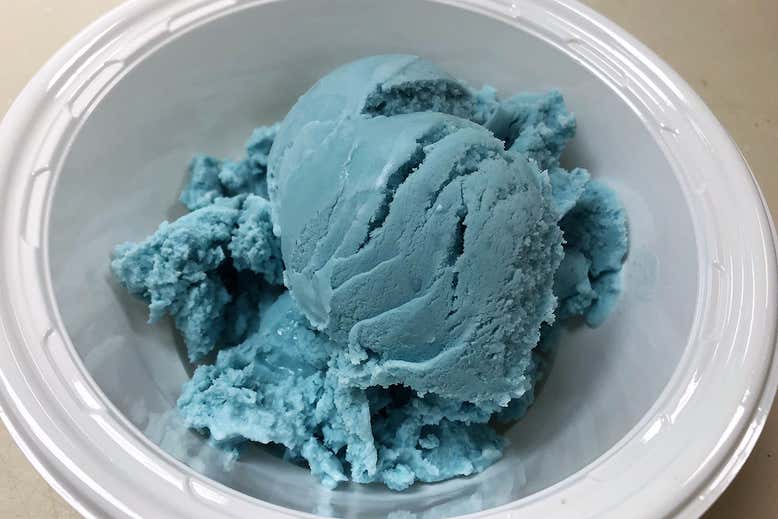博文
卷心菜中发现的一类新型蓝色物质可以代替合成食用染料
 精选
精选
||
卷心菜中发现的一类新型蓝色物质可以代替合成食用染料
诸平
艾丽斯·克莱恩(Alice Klein) 2021年4月7日在《新科学家》(New Scientist)报道了由卷心菜中发现的一种新型蓝色物质,它可以代替合成食用染料。图示是美国加州大学戴维斯分校(University of California, Davis)帕梅拉·德尼什(Pamela Denish)提供的使用新型蓝色颜料制成的冰淇淋。相关研究结果于2021年4月7日已经在《科学进展》(Science Advances)杂志网站发表——Pamela R. Denish, Julie-Anne Fenger, Randall Powers, Gregory T. Sigurdson, Luca Grisanti, Kathryn G. Guggenheim, Sara Laporte, Julia Li, Tadao Kondo, Alessandra Magistrato, Mícheál P. Moloney, Mary Riley, Mariami Rusishvili, Neda Ahmadiani, Stefano Baroni, Olivier Dangles, Monica Giusti, Thomas M. Collins, John Didzbalis, Kumi Yoshida, Justin B. Siegel, Rebecca J. Robbins. Discovery of a natural cyan blue: A unique food-sourced anthocyanin could replace synthetic brilliant blue. Science Advances, 07 Apr 2021: Vol. 7, no. 15, eabe7871. DOI: 10.1126/sciadv.abe7871. https://advances.sciencemag.org/content/7/15/eabe7871

Ice cream made using the new blue pigment. Pamela Denish, University of California, Davis
科学家们在白菜中发现一种可以起到这种作用的蓝色颜料后,对人造蓝色食用色素的天然替代品的长期寻找可能已经结束。
在植物和岩石等自然资源中很少发现蓝色颜料,这意味着大多数蓝色产品(包括糖果、饮料、药片、化妆品和衣物)都必须使用合成蓝色染料制造。这些合成染料通常由石化产品制成,导致人们担心它们对环境的影响以及作为食品添加剂的安全性。
科学家们花了数十年的时间寻找天然的替代品。现在,加利福尼亚大学戴维斯分校的帕梅拉·德尼什(Pamela Denish)和她的同事们在红甘蓝(red cabbage)中发现了一种类似于人造食用色素Brilliant Blue FCF或E133的色素(Brilliant Blue FCF or E133)。这种天然的蓝色颜料仅在红卷心菜中少量存在。它是花青素分子(anthocyanin molecule)的一种类型。
然而,研究人员发现,他们可以用一种特殊设计的酶处理红色卷心菜中存在的主要红色花青素(red-coloured anthocyanins),使其变成蓝色,从而可以使其大量生产。
该团队使用这种新的蓝色颜料制作了蓝色冰淇淋、甜甜圈糖霜和糖衣扁豆。这些产品在环境条件下保存30天时仍保持蓝色。
该研究的作者之一,日本名古屋大学(Nagoya University in Japan)的吉田久美(Kumi Yoshida)说,必须先进行安全测试,然后才能在食品中使用该天然蓝色染料。她说:“红甘蓝花青素类(anthocyanins)在我们的饮食中有很长的历史。”
美国玛氏箭牌全球创新中心的丽贝卡·罗宾斯(Rebecca Robbins)表示,之所以在自然界中如此稀少,是因为蓝色需要复杂的分子结构才能吸收正确的波长以呈现蓝色。丽贝卡·罗宾斯也是此项研究的通讯作者,她说:“这需要相当多的特定分子特征。”
参与此项研究的除了美国加州大学戴维斯分校的研究人员之外,还有来自美国玛氏箭牌公司(Mars Wrigley)、俄亥俄州立大学(Ohio State University)、芝加哥大学(University of Chicago)、玛氏高等研究所(Mars Advanced Research Institute)、玛氏箭牌全球创新中心(Mars Wrigley Global Innovation Center);法国阿维尼翁大学(Avignon University);意大利Scuola Internazionale Superiore di Studi Avanzati;克罗地亚Institut Ruđer Bošković;日本名古屋大学(Nagoya University)以及西班牙Universidad Autònoma de Barcelona的研究人员。上述介绍仅供参考,更多信息敬请注意浏览原文或者相关报道:新蓝调:寻求制作世界上最稀有的颜色(New blues: The quest to make the world’s rarest colour)
The color of food is critical to the food and beverage industries, as it influences many properties beyond eye-pleasing visuals including flavor, safety, and nutritional value. Blue is one of the rarest colors in nature’s food palette—especially a cyan blue—giving scientists few sources for natural blue food colorants. Finding a natural cyan blue dye equivalent to FD&C Blue No. 1 remains an industry-wide challenge and the subject of several research programs worldwide. Computational simulations and large-array spectroscopic techniques were used to determine the 3D chemical structure, color expression, and stability of this previously uncharacterized cyan blue anthocyanin-based colorant. Synthetic biology and computational protein design tools were leveraged to develop an enzymatic transformation of red cabbage anthocyanins into the desired anthocyanin. More broadly, this research demonstrates the power of a multidisciplinary strategy to solve a long-standing challenge in the food industry.
https://blog.sciencenet.cn/blog-212210-1281096.html
上一篇:国际研究正朝着改进用于量子传感器技术的材料前进
下一篇:抑制SAM生物合成减缓肿瘤生长